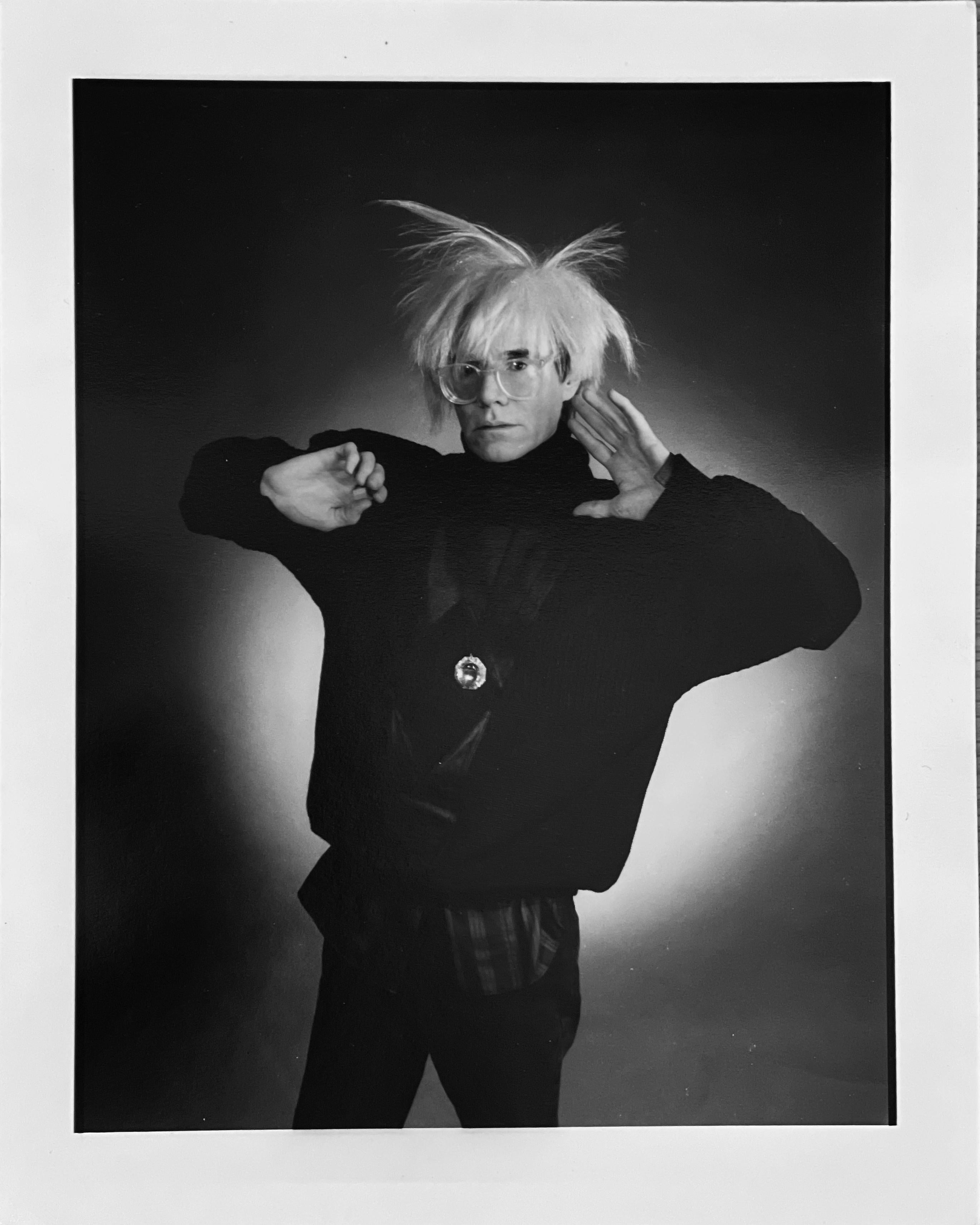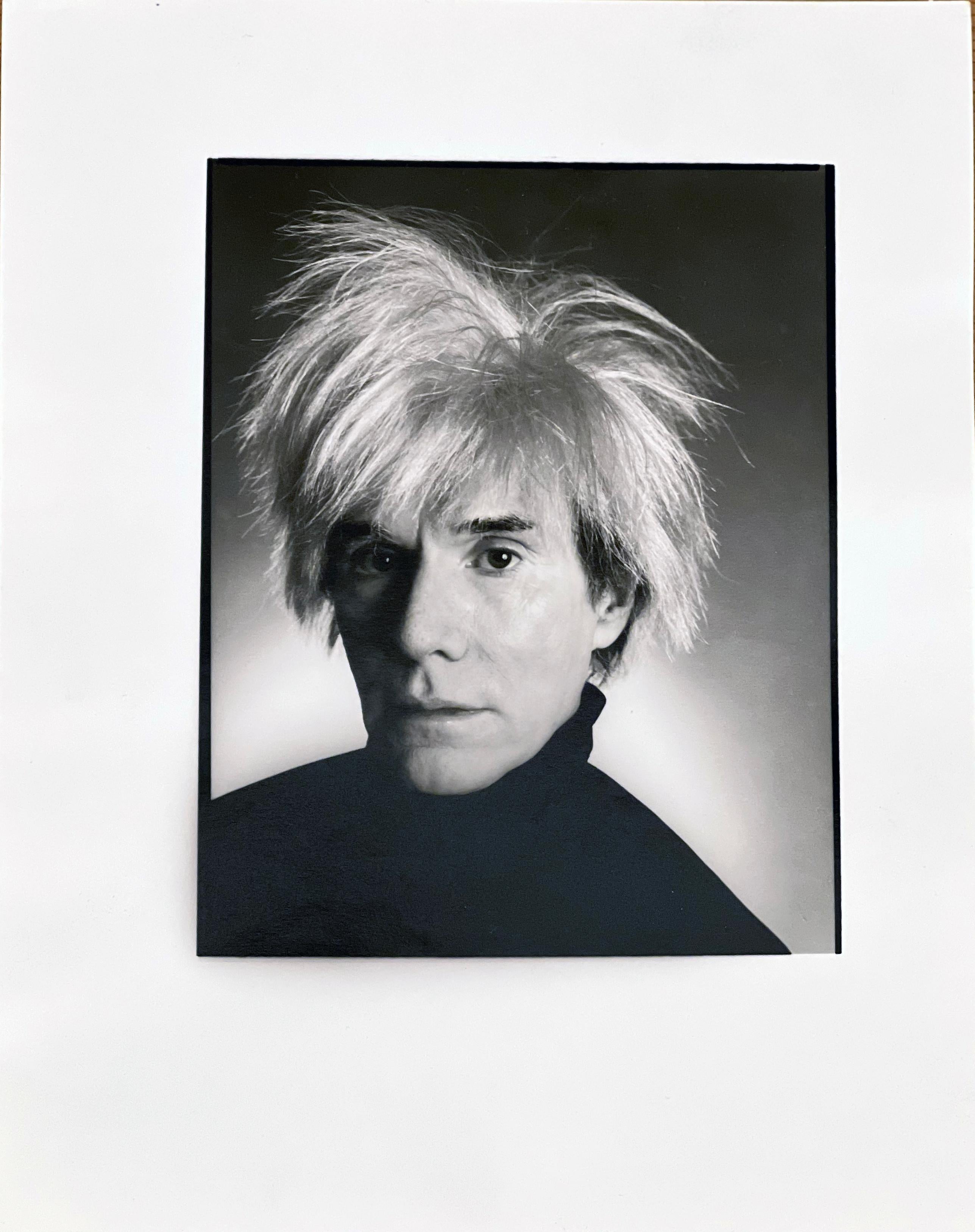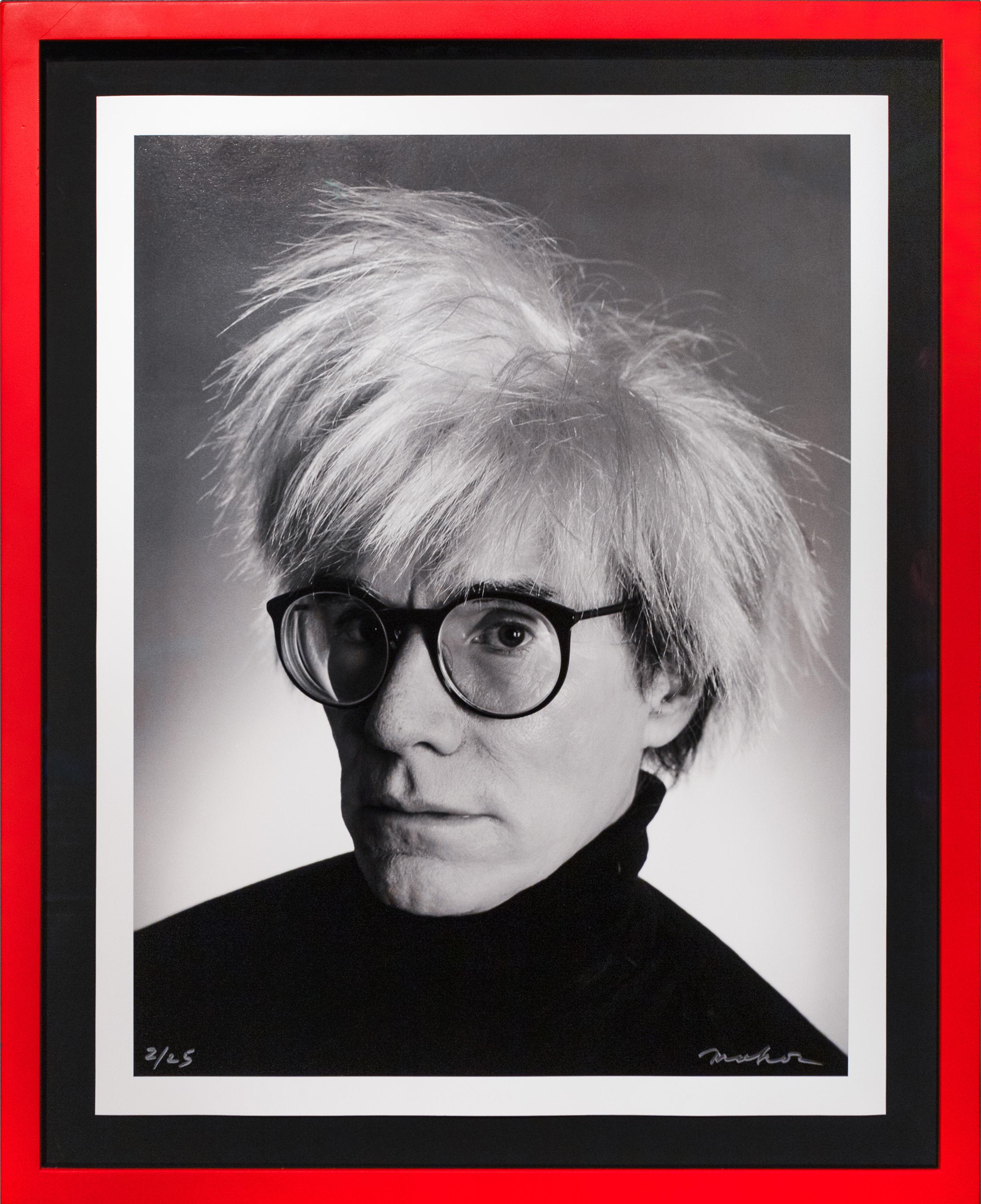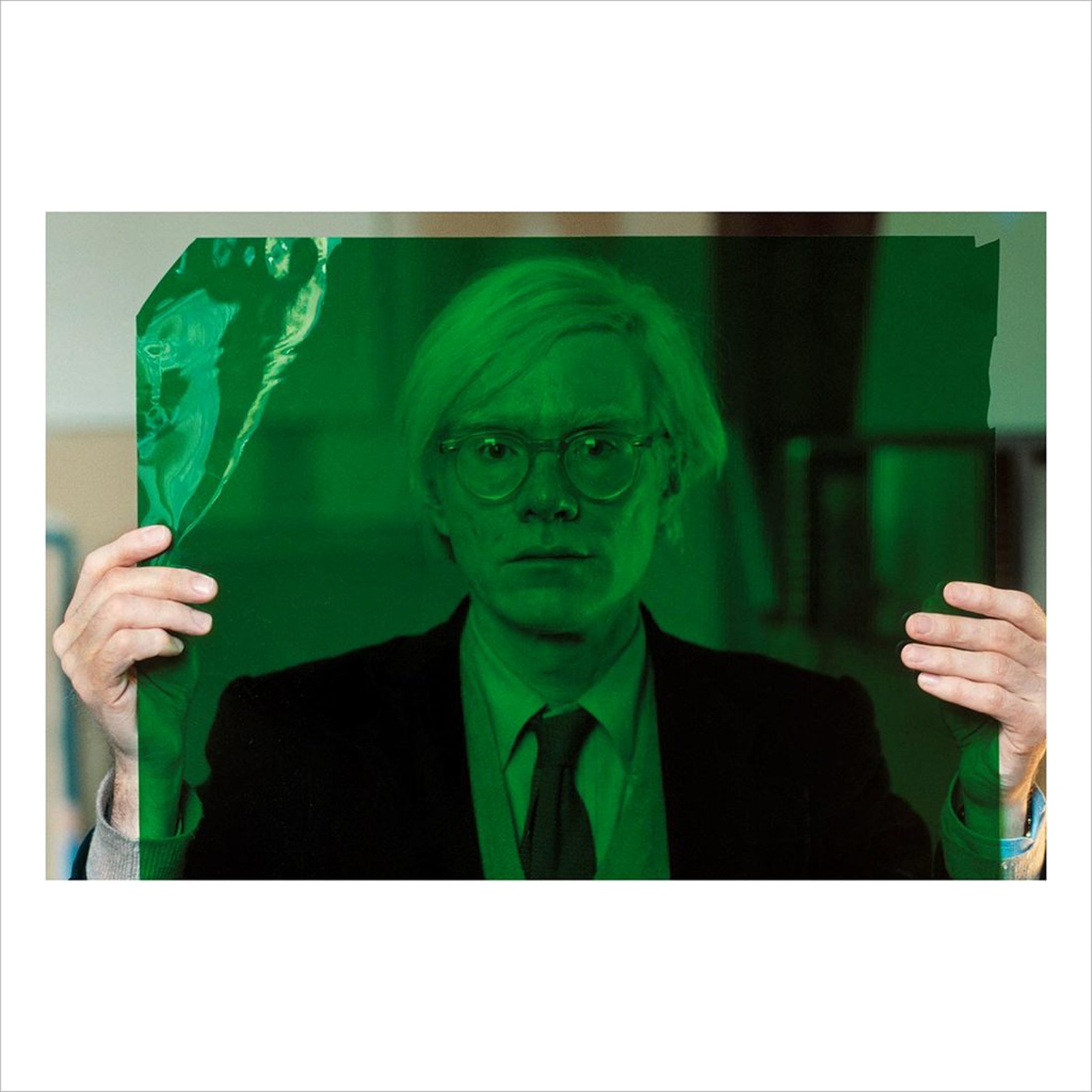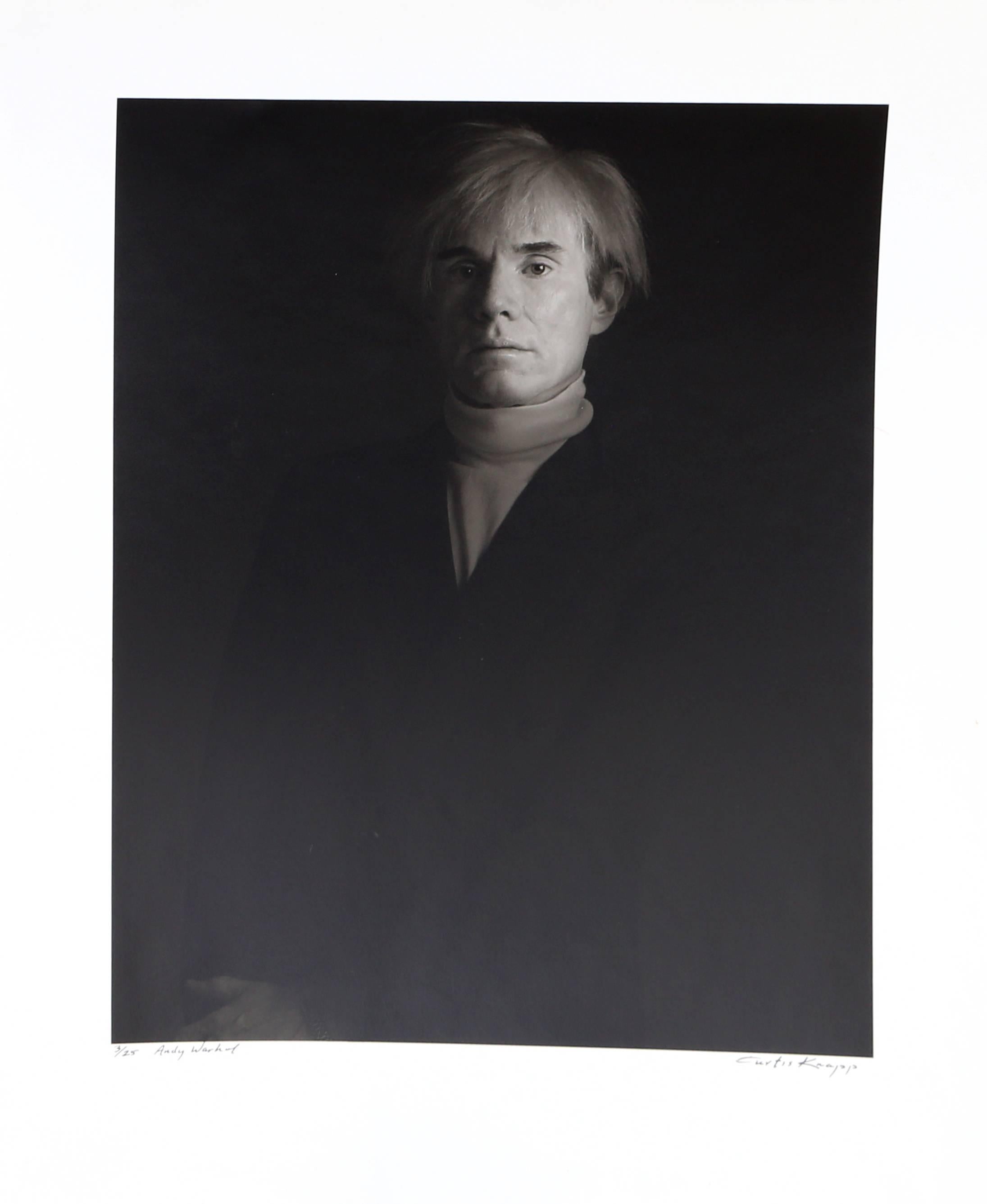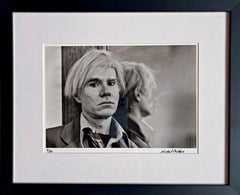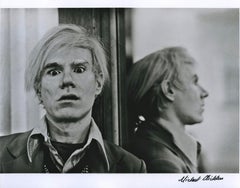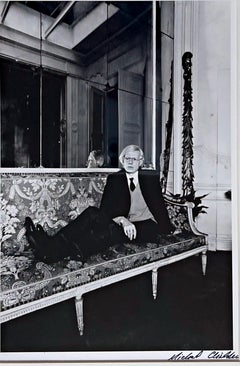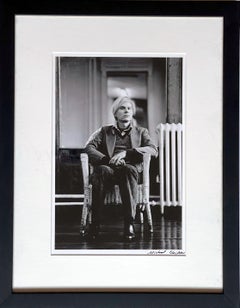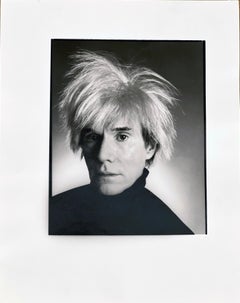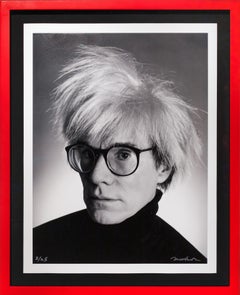Items Similar to Portrait of Andy Warhol, hand signed by BOTH Andy Warhol and Christopher Makos
Want more images or videos?
Request additional images or videos from the seller
1 of 14
Christopher Makos and Andy WarholPortrait of Andy Warhol, hand signed by BOTH Andy Warhol and Christopher Makos1986
1986
$20,000
£15,093.45
€17,279.72
CA$28,206.63
A$30,967.36
CHF 16,155.74
MX$374,748.20
NOK 202,487.12
SEK 190,796.10
DKK 128,988.49
About the Item
Christopher Makos, Andy Warhol
Portrait of Andy Warhol taken by photographer Christopher Makos
(Hand signed by BOTH Andy Warhol and Christopher Makos), 1986
Gelatin Silver Print, hand signed and annotated by Andy Warhol, Hand signed by Christopher Makos with studio stamp and copyright
Hand signed and annotated "Xtra" by Andy Warhol; hand signed, dated and stamped by Christopher Makos with copyright
Frame included: elegantly framed in a museum quality wood frame with UV plexiglass; there is a die cut window on the back to reveal the signatures, annotations and copyright stamp
A rare proof hand signed by both photographer and subject:
Hand signed and annotated "Xtra" by Andy Warhol on the back; hand signed, dated and stamped by Christopher Makos with this copyright
Accompanied by gallery issued Certificate of Guarantee
Measurements:
Frame:
19 x 16.75 x 1.75 inches
Photograph:
12.25 x 10.25 inches
About Christopher Makos:
Christopher Makos was born in Lowell, Massachusetts, grew up in California, and moved to New York after high school. He studied architecture in Paris and briefly worked as an apprentice to Man Ray. Andy Warhol, Makos' good friend and frequent portrait subject, called Makos "the most modern photographer in America." His photographs have been exhibited in galleries and museums such as the Guggenheim Museum in Bilbao, the Tate Modern in London, the Whitney Museum of American Art in New York, the IVAM in Valencia (Spain) and the Reina Sofia Museum in Madrid. His pictures have appeared in magazines and newspapers, including Paris Match and Wall Street Journal. He is the author of several important books, like the volumes Warhol/Makos In Context (2007), Andy Warhol China 1982 (2007) and Christopher Makos Polaroids (2009).
Courtesy of Makostudio
About Andy Warhol:
Isn’t life a series of images that change as they repeat themselves?
—Andy Warhol
Andy Warhol’s (1928–1987) art encapsulates the 1960s through the 1980s in New York. By imitating the familiar aesthetics of mass media, advertising, and celebrity culture, Warhol blurred the boundaries between his work and the world that inspired it, producing images that have become as pervasive as their sources.
Warhol grew up in a working-class suburb of Pittsburgh. His parents were Slovak immigrants, and he was the only member of his family to attend college. He entered the Carnegie Institute of Technology (now Carnegie Mellon University) in 1945, where he majored in pictorial design. After graduation, he moved to New York with fellow student Philip Pearlstein and found steady work as a commercial illustrator at several magazines, including Vogue, Harper’s Bazaar, and the New Yorker. Throughout the 1950s Warhol enjoyed a successful career as a commercial artist, winning several commendations from the Art Directors Club and the American Institute of Graphic Arts. He had his first solo exhibition at the Hugo Gallery in 1952, showing drawings based on the writings of Truman Capote; three years later his work was included in a group show at the Museum of Modern Art for the first time.
The year 1960 marked a turning point in Warhol’s prolific career. He painted his first works based on comics and advertisements, enlarging and transferring the source images onto canvas using a projector. In 1961 Warhol showed these hand-painted works, including Little King (1961) and Saturday’s Popeye (1961), in a window display at the department store Bonwit Teller; in 1962 he painted his famous Campbell’s Soup Cans, thirty-two separate canvases, each depicting a canned soup of a different flavor. Soon after, Warhol began to borrow not only the subject matter of printed media, but the technology as well. Incorporating the silkscreen technique, he created grids of stamps, Coca-Cola bottles, shipping and handling labels, dollar bills, coffee labels, and more, breaking down the images to their basic graphic components.
In 1963 Warhol established a studio on East 47th Street, which became known as the Factory and served as a cultural hub for artists, models, performers, and socialites. His inner circle comprised his Superstars, who played a major role in both his work and his social life. Interested in the production of fame, Warhol began to screen-print images of celebrities and public figures, from Marilyn Monroe and Elvis Presley to Jackie Kennedy and Mao Zedong. Expanding his practice, as well as his cultural influence, he produced records (The Velvet Underground & Nico), started a magazine (Interview), and made avant-garde films, such as Chelsea Girls (1966), Blow Job (1964), and Empire (1964), which have become classics of the underground genre.
Following a close run-in with death when Valerie Solanas shot him in 1968, Warhol entered a more subdued, isolated period, working primarily on a commissioned basis and painting portraits for various patrons, while also revisiting themes from his earlier work. He then began to pursue a new interest in abstraction, first with his Oxidations (1977–78), made by allowing friends and acquaintances to urinate on canvases painted with metallic pigments, and later with his Rorschach (1984) and Camouflage (1986) paintings.
By the early 1980s Warhol was producing work across media with a renewed vigor, hosting half-hour programs on MTV, publishing books, and collaborating with younger artists including Jean-Michel Basquiat, Francesco Clemente, and Keith Haring. His abstract series coincided with large-scale works that looked back at masterpieces by Leonardo da Vinci: he screen-printed images of the Mona Lisa (1503) and created several monumental canvases of The Last Supper (1495–98). Warhol’s ability to seamlessly combine art historical reference, abstract patterns, and mass media set new standards for the role of the artist, permanently blurring the lines between commercial and fine art.
Courtesy of Gagosian Gallery
- Creator:Christopher Makos and Andy Warhol (1930, American)
- Creation Year:1986
- Dimensions:Height: 19 in (48.26 cm)Width: 16.75 in (42.55 cm)Depth: 1.75 in (4.45 cm)
- Medium:
- Movement & Style:
- Period:
- Condition:Ships framed.
- Gallery Location:New York, NY
- Reference Number:1stDibs: LU1745215543792
About the Seller
5.0
Platinum Seller
Premium sellers with a 4.7+ rating and 24-hour response times
Established in 2007
1stDibs seller since 2022
451 sales on 1stDibs
Typical response time: 2 hours
- ShippingRetrieving quote...Shipping from: New York, NY
- Return Policy
Authenticity Guarantee
In the unlikely event there’s an issue with an item’s authenticity, contact us within 1 year for a full refund. DetailsMoney-Back Guarantee
If your item is not as described, is damaged in transit, or does not arrive, contact us within 7 days for a full refund. Details24-Hour Cancellation
You have a 24-hour grace period in which to reconsider your purchase, with no questions asked.Vetted Professional Sellers
Our world-class sellers must adhere to strict standards for service and quality, maintaining the integrity of our listings.Price-Match Guarantee
If you find that a seller listed the same item for a lower price elsewhere, we’ll match it.Trusted Global Delivery
Our best-in-class carrier network provides specialized shipping options worldwide, including custom delivery.More From This Seller
View AllAndy Warhol in New York, 1976, 2007, hand signed photograph 8/60 for Museum
By Michael Childers
Located in New York, NY
Michael Childers
Andy Warhol in New York, 1976, 2007
Photographic print
Signed and numbered 8/60 on the front in black felt tip marker
Frame included
...
Category
Early 2000s Pop Art Black and White Photography
Materials
Photographic Paper, Permanent Marker
Andy Warhol in his New York studio, 1976 (Palm Springs Art Museum) Signed Framed
By Michael Childers
Located in New York, NY
MICHAEL CHILDERS
Andy Warhol in his New York studio, 1976
Photographic print
Printed in 2007
Signed boldly on the front in black felt tip pen by photographer Michael Childers
Frame included: in the original frame as donated by the photographer to the Palm Springs Art Museum
This is one of a series of portraits of Andy Warhol by Michael Childers, founding photographer of Warhol's Interview and After Dark magazines, taken in his New York studio and Paris from 1976-1980. This work is signed on the front and framed. It was acquired from the Palm Springs Art Museum, where it was donated by the artist.
The verso of the frame bears the works title, original year in felt tip marker, and the artist's studio stamp with copyright of 2007 (year printed)
Another example of this work was exhibited at the Palm Springs Art Museum and a different example is part of the Michael Childers collection at the Las Vegas Art Museum
Measurements:
Artwork (visible): 7 x 9 7/8 inches
Frame: 12 x 15 x .4 inches
Michael Childers Biography:
Since the 1960s, Michael Childers has been photographing famous people...
Category
1970s Pop Art Portrait Photography
Materials
Photographic Paper
Andy Warhol in Paris, 1980, Signed photograph, acquired from Palm Springs Museum
By Michael Childers
Located in New York, NY
Michael Childers
Andy Warhol in Paris. from Palm Springs Art Museum, 1976-1980, 2007
Gelatin Silver Print
Boldly signed in black felt tip pen on the f...
Category
1980s Pop Art Portrait Photography
Materials
Silver Gelatin, Permanent Marker, Photographic Paper
Andy Warhol in his studio, 1987 (for the Palm Springs Art Museum)
By Michael Childers
Located in New York, NY
Michael Childers
Andy Warhol in his studio, 1987, 2007
Photographic print
Hand Signed on the lower right front in black felt tip marker
Frame Included
This is one of a series of port...
Category
Early 2000s Realist Black and White Photography
Materials
Photographic Paper
Films of Andy Warhol, Whitney Museum framed poster (Hand Signed by Billy Name)
By Billy Name
Located in New York, NY
Billy Name
Films of Andy Warhol, Whitney Museum of American Art (Hand Signed by Billy Name), 1988
Offset Lithograph
Very rare vintage poster - hand signed by Billy Name on the front.
Frame Included
Very rare vintage poster - when hand signed by Warhol...
Category
1980s Pop Art Portrait Prints
Materials
Lithograph, Offset, Permanent Marker
Andy Warhol in Paris with Sitting Bird 1976 signed photo Palm Springs Art Museum
By Michael Childers
Located in New York, NY
Michael Childers
Andy Warhol in Paris with Sitting Bird 1976, 2007
Photographic print
hand signed in black felt tip pen lower right front; the back be...
Category
1970s Pop Art Black and White Photography
Materials
Permanent Marker, Photographic Paper
You May Also Like
Portrait of Andy Warhol, Black and White Photography of Celebrity Artist
By Christopher Makos
Located in New york, NY
Portrait of Andy Warhol, 1986 by Christopher Makos is an 10 x 8in vintage gelatin silver print on fiber paper. The photograph is stamped (in black ink) on verso (photo back). Provenance: Private Collector *** Artist’s Bio: Christopher Makos (1948- ) is an American photographer and visual artist. He studied architecture in Paris and was an apprentice to Man Ray. Andy Warhol was Makos' good friend and frequent portrait subject. His photographs of Andy Warhol have been exhibited in galleries and museums, including the Guggenheim Museum in Bilbao,Tate Modern in London, Whitney Museum of American Art in New York, IVAM in Valencia (Spain), Reina Sofia Museum in Madrid, among others. Makos’ pictures have appeared in publications, including Paris Match and the Wall Street Journal. The visual artist is the author of numerous books, such as Warhol/Makos In Context (2007), Andy Warhol China...
Category
1980s Contemporary Black and White Photography
Materials
Photographic Film, Photographic Paper, Silver Gelatin
Andy Warhol Portrait, Black and White Photography of Celebrity Artist
By Christopher Makos
Located in New york, NY
Andy Warhol Portrait, 1986 by Christopher Makos is an 10 x 8in vintage gelatin silver print on fiber paper. The photograph is stamped (in black ink) on verso (photo back). Provenance: Private Collector *** Artist’s Bio: Christopher Makos (1948- ) is an American photographer and visual artist. He studied architecture in Paris and was an apprentice to Man Ray. Andy Warhol was Makos' good friend and frequent portrait subject. His photographs of Andy Warhol have been exhibited in galleries and museums, including the Guggenheim Museum in Bilbao,Tate Modern in London, Whitney Museum of American Art in New York, IVAM in Valencia (Spain), Reina Sofia Museum in Madrid, among others. Makos’ pictures have appeared in publications, including Paris Match and the Wall Street Journal. The visual artist is the author of numerous books, such as Warhol/Makos In Context (2007), Andy Warhol China...
Category
1980s Contemporary Black and White Photography
Materials
Photographic Film, Photographic Paper, Silver Gelatin
Archival Andy Warhol Black and White Portrait, 2020
By Christopher Makos
Located in New York, NY
The ‘Archival Andy Warhol Portrait,’ taken by Christopher Makos, is a nostalgic photograph of the beloved pop-art icon, and Makos’ dear friend, Andy Warhol. The two artists had a won...
Category
2010s Pop Art Black and White Photography
Materials
Archival Paper
Favorite Portrait (Andy Warhol), Silver Gelatin Print by Christopher Makos
By Christopher Makos
Located in Long Island City, NY
Artist: Christopher Makos, American (1948 - )
Title: Andy Warhol with Glasses
Year: 1986 (printed 1989)
Medium: Gelatin Silver Print, signed, stamped and numbered verso
Edition: 15/3...
Category
1980s Contemporary Portrait Photography
Materials
Silver Gelatin
Signed Thomas Hoepker Magnum Print of Andy Warhol, NY 1981
Located in London, GB
For sale a fantastic, original signed museum-quality Magnum 6x6 photographic print of Andy Warhol by renowned and iconic German photographer Thomas Hoepker.
Titled "Andy Warhol in his "Factory" at Union Square. New York City, USA. 1981", this Magnum print...
Category
Late 20th Century American Contemporary Art
Materials
Paper
Andy Warhol Photo Portrait by Curtis Knapp
By Curtis Knapp
Located in Long Island City, NY
Artist: Curtis Knapp, American
Title: Andy Warhol
Year: 1983 (printed 1991)
Medium: Silver Print on Fiber Paper, signed and numbered in ink
Edition: 25
Size: 17 in. x 14 in. (43.18 ...
Category
1980s Post-Modern Portrait Photography
Materials
Silver Gelatin
More Ways To Browse
Vintage Bonwit Teller Vintage
Andy Warhol 1986
Vintage Coca Cola Bottles
Vintage Coffee Labels
Andy Warhol Hand Signed
Andy Warhol Signed Dollar Bill
Lou Michaels
Marilyn Monroe Pearls
Mick Rock Signed
One Million Years Bc Poster
Osvaldo Salas
Photography Fred Astaire
Photography Robert Redford
Slim Aarons Tiger
Sonny And Cher
Arnold Palmer
August Becker
Bert Stern Crucifix
